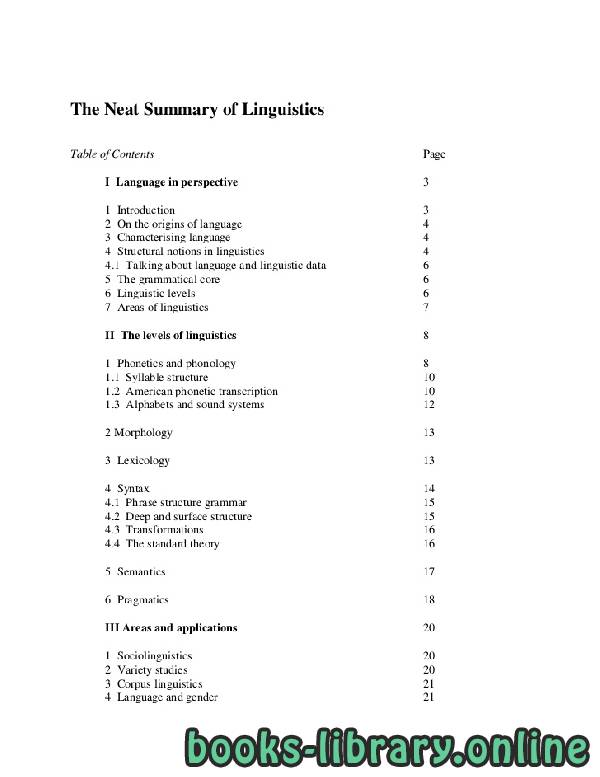📘 قراءة كتاب The Neat Summary of Linguistics أونلاين


هذا يحتوي يحتوى علي معلومات خاصة بعلم اللغويات
هي علم يهتم بدراسة اللغات الإنسانية ودراسة خصائصها وتراكيبها ودرجات التشابه والتباين فيما بينها.و يدرس اللغة من كل جوانبها دراسة شاملة.
أما اللغوي فهو الشخص الذي يقوم بهذه الدراسة. ظهرت اللسانيات الحديثة في القرن 19م، لكنها كعلم قديمة قدم الإنسان. جاءت بفكرة رئيسة مع العالم فرديناند دو سوسور فمع علمنة الثورة الصناعية أراد علمنة اللغة أيضا في كتابه /محاضرات في اللسانيات العامة/ فاللغة عنده تحمل هويات من قيم الدين، والمحيط، والثقافة، والفكر الفلسفي.
Linguistics is the scientific study of language. It involves analysing language form, language meaning, and language in context. The earliest activities in the documentation and description of language have been attributed to the 6th-century-BC Indian grammarian Pāṇini who wrote a formal description of the Sanskrit language in his Aṣṭādhyāyī.[5]
Linguists traditionally analyse human language by observing an interplay between sound and meaning. Phonetics is the study of speech and non-speech sounds, and delves into their acoustic and articulatory properties. The study of language meaning, on the other hand, deals with how languages encode relations between entities, properties, and other aspects of the world to convey, process, and assign meaning, as well as manage and resolve ambiguity. While the study of semantics typically concerns itself with truth conditions, pragmatics deals with how situational context influences the production of meaning
Grammar is a system of rules which governs the production and use of utterances in a given language. These rules apply to sound as well as meaning, and include componential subsets of rules, such as those pertaining to phonology (the organisation of phonetic sound systems), morphology (the formation and composition of words), and syntax (the formation and composition of phrases and sentences). Many modern theories that deal with the principles of grammar are based on Noam Chomsky's framework of generative linguistics.]
In the early 20th century, Ferdinand de Saussure distinguished between the notions of langue and parole in his formulation of structural linguistics. According to him, parole is the specific utterance of speech, whereas langue refers to an abstract phenomenon that theoretically defines the principles and system of rules that govern a language. This distinction resembles the one made by Noam Chomsky between competence and performance in his theory of transformative or generative grammar. According to Chomsky, competence is an individual's innate capacity and potential for language (like in Saussure's langue), while performance is the specific way in which it is used by individuals, groups, and communities (i.e., parole, in Saussurean term
The Neat Summary of Linguistics
Table of Contents Page
I Language in perspective 3
1 Introduction 3
2 On the origins of language 4
3 Characterising language 4
4 Structural notions in linguistics 4
4.1 Talking about language and linguistic data 6
5 The grammatical core 6
6 Linguistic levels 6
7 Areas of linguistics 7
II The levels of linguistics 8
1 Phonetics and phonology 8
1.1 Syllable structure 10
1.2 American phonetic transcription 10
1.3 Alphabets and sound systems 12
2 Morphology 13
3 Lexicology 13
4 Syntax 14
4.1 Phrase structure grammar 15
4.2 Deep and surface structure 15
4.3 Transformations 16
4.4 The standard theory 16
5 Semantics 17
6 Pragmatics 18
III Areas and applications 20
1 Sociolinguistics 20
2 Variety studies 20
3 Corpus linguistics 21
4 Language and gender 21
5 Language acquisition 22
6 Language and the brain 23
7 Contrastive linguistics 23
8 Anthropological linguistics 24
IV Language change 25
1 Linguistic schools and language change 26
2 Language contact and language change 26
3 Language typology 27
V Linguistic theory 28
VI Review of linguistics 28
1 Basic distinctions and definitions 28
2 Linguistic levels 29
3 Areas of linguistics 31
VII A brief chronology of English 33
1 External history 33
1.1 The Germanic languages 33
1.2 The settlement of Britain 34
1.3 Chronological summary 36
2 Internal history 37
2.1 Periods in the development of English 37
2.2 Old English 37
2.3 Middle English 38
2.4 Early Modern English
5 Language acquisition 226 Language and the brain 237 Contrastive linguistics 238 Anthropological linguistics 24IV Language change251 Linguistic schools and language change 262 Language contact and language change 263 Language typology 27V Linguistic theory28VI Review of linguistics281 Basic distinctions and definitions 282 Linguistic levels 293 Areas of linguistics 31VII A brief chronology of English331 External history 331.1 The Germanic languages 331.2 The settlement of Britain 341.3 Chronological summary 362 Internal history 372.1 Periods in the development of English 372.2 Old English 372.3 Middle English 382.4 Early Modern English 40Raymond Hickey The Neat Summary of LinguisticsPage 2 of 40
Introduction to Linguistics
introduction to linguistics pdf
branches of linguistics pdf
general linguistics pdf
linguistics pdf books free download
concept of linguistics
introduction to language
language in linguistics
schools of linguistics pdf
Linguistics
linguistics lessons
types of linguistics
what is linguistics pdf
purpose of linguistics
why study linguistics?
branches of linguistics
modern linguistics summary
characteristics of linguistics
سنة النشر : 2017م / 1438هـ .
حجم الكتاب عند التحميل : 0.1MB .
نوع الكتاب : pdf.
عداد القراءة:
اذا اعجبك الكتاب فضلاً اضغط على أعجبني و يمكنك تحميله من هنا:

شكرًا لمساهمتكم
شكراً لمساهمتكم معنا في الإرتقاء بمستوى المكتبة ، يمكنكم االتبليغ عن اخطاء او سوء اختيار للكتب وتصنيفها ومحتواها ، أو كتاب يُمنع نشره ، او محمي بحقوق طبع ونشر ، فضلاً قم بالتبليغ عن الكتاب المُخالف:
 قبل تحميل الكتاب ..
قبل تحميل الكتاب ..
يجب ان يتوفر لديكم برنامج تشغيل وقراءة ملفات pdf
يمكن تحميلة من هنا 'http://get.adobe.com/reader/'


 منصّة المكتبة
منصّة المكتبة 